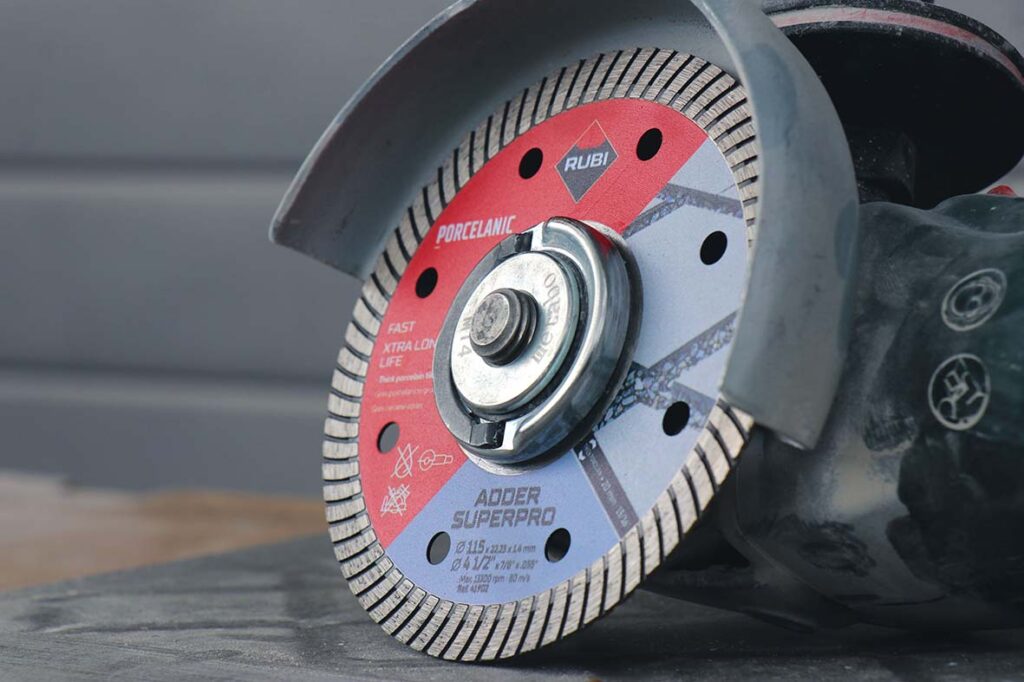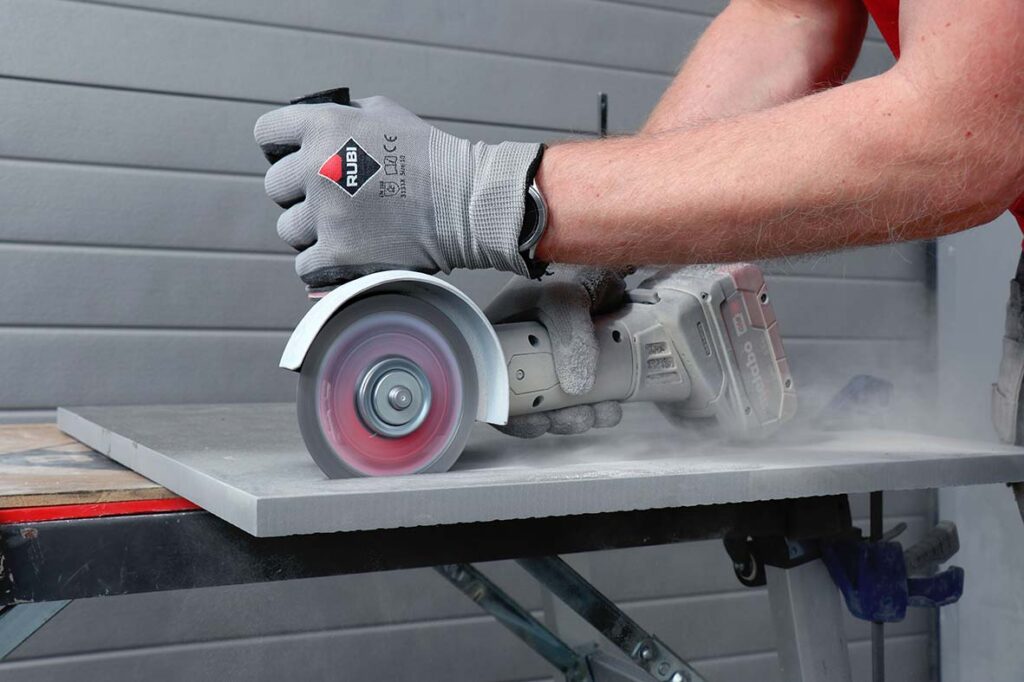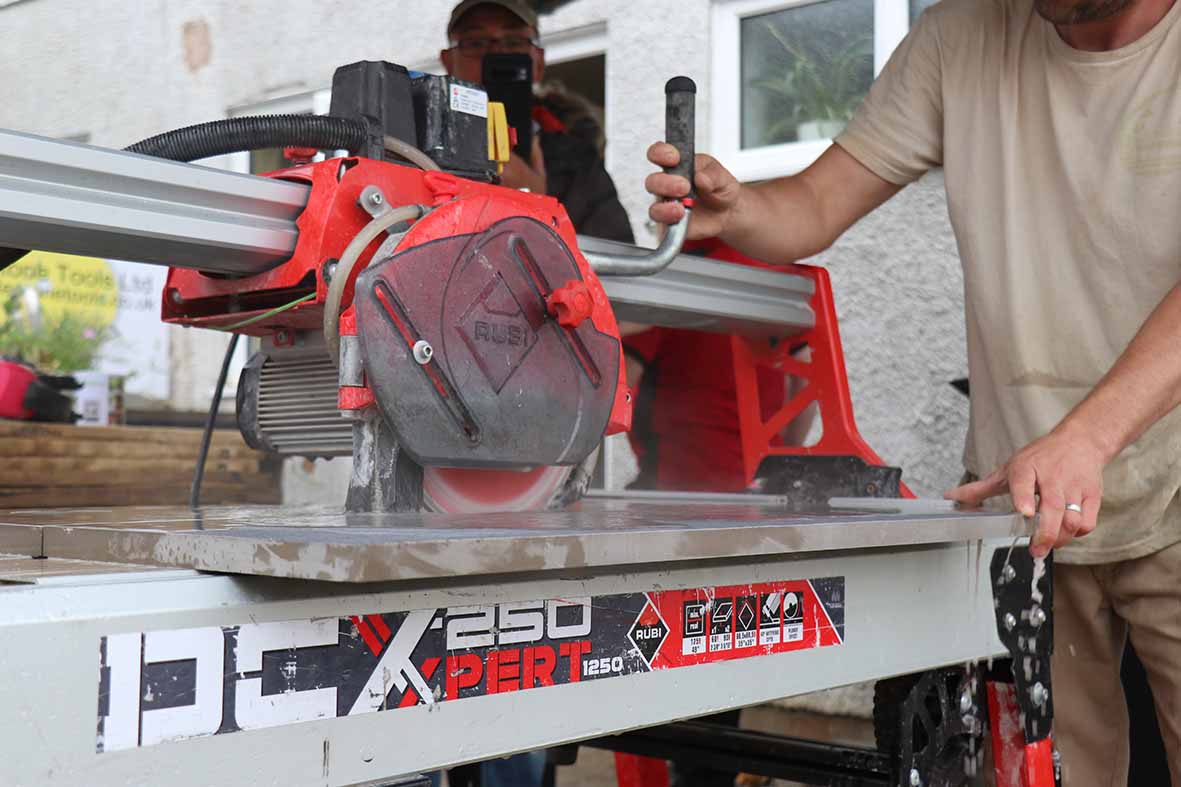Cutting 20mm tiles, particularly porcelain or stone, presents a unique set of challenges. These thick tiles are often hard to cut, requiring specific tools and techniques to achieve the best result. In this blog we will discuss how to tile and cut 20mm tiles, as well as how to extend the life of your diamond blade.


Tools for Cutting 20mm Tiles
Whether you’re a seasoned professional or a DIY enthusiast, choosing the right equipment and using proper cutting techniques can dramatically improve both the quality of the cut and the lifespan of your blade. We will explore several popular tools for cutting 20mm tiles while offering key tips on how to achieve superior results.
Angle Grinder
An angle grinder is one of the most versatile tools for landscapers and tilers alike. It’s also handy for cutting 20mm tiles. This handheld device is ideal for smaller cuts, detailed work, and curved cuts. When equipped with the proper blade, an angle grinder can cut through materials such as porcelain, ceramic, and natural stone.
However, due to its handheld nature, maintaining accuracy with an angle grinder requires a steady hand and practice. Using a diamond blade specifically designed for cutting 20mm tiles is essential to prevent chipping or uneven cuts. Remember that angle grinders operate at high speed, so controlling the speed of the cut is critical to getting a smooth finish while extending the blade’s lifespan. At RUBI we have developed our Adder blade, which is designed for cutting through 20mm porcelain in one pass on an angle grinder.
Bridge Saw
RUBI has designed bridge saws as powerful tools for heavy-duty tile cutting, especially for large and thick tiles like 20mm porcelain or stone slabs. It allows for precise, straight cuts thanks to its guided rail system. RUBI offers a range of bridge saws, all of which feature a water-cooling system that cools and cleans the blade during use. Water can help to prolong the life of blades and ensure a smooth cut by reducing heat and minimising dust.
All RUBI bridge saws require the use of wet blades, which must be used with water. Remember, dry blades can cut wet and dry, but wet blades must always be used wet.

When using a bridge saw, it’s important to select a blade designed for cutting the material you are working with. For porcelain, this typically means using a high-quality diamond blade specifically labelled for 20mm thickness to avoid excessive wear and ensure the highest quality cut. We recommend our SPT blade.
Circular Saw
You can also use a circular saw to cut 20mm tiles when paired with the right blade. Although people more commonly associate circular saws with cutting wood, manufacturers design specific circular saws for cutting through porcelain and natural stone materials. The RUBI TC-125 G2 is an example.
These saws can be quite effective with tiles when fitted with a wet or dry diamond blade. A circular saw strikes a good balance between an angle grinder and a bridge saw, providing more control than a handheld grinder while being more portable than a large bridge saw.
Like with any other tool, blade choice is critical. Make sure the blade is designed for the specific material you’re cutting. This could be porcelain or natural stone. Porcelain blades are not universal—some are made specifically for thicker materials like 20mm tiles.

Tips to Prolong the Life of Your Blade and Improve Cut Quality
Now that you know what type of tools you can work with when cutting 20mm tiles, it’s now time to discuss how to extend the life of your blades.
Speed of Cut and Blade Control
One of the most crucial factors in preserving your blade while achieving a clean, smooth cut is controlling the speed at which you cut. Cutting too quickly generates excessive heat, leading to premature blade wear and rough cuts.
The key is to let the blade do the work. Never force the blade through the tile. Instead, guide the tool at a steady, moderate speed, allowing the blade to glide smoothly through the material. This not only prolongs the life of the blade but also results in a higher-quality cut.
Use The Right Blade
Not all blades are created equal, and this is particularly true when cutting 20mm tiles. Diamond blades are often the go-to choice for hard materials like porcelain, but make sure you’re using a blade specifically designed for thick porcelain or stone. A porcelain blade designed for standard thickness may wear out quickly when used on 20mm tiles. Additionally, a blade specifically rated for 20mm materials will handle the job much more effectively and with less wear.

Sharpening the Blade
Regularly sharpening your cutting blade can dramatically extend its lifespan. In fact, sharpening the blade with an abrasive block can sometimes double the blade’s usability.
You should be able to see, feel, and hear when a blade needs sharpening. If you blade is looking dull, you can bring the diamond particles back up to the surface by using a sharpening stone.
If you find that your cuts are not equal (cutting 1-3 mm out at either end) the first thing you should do is sharpen your blade. A dull blade will force its way through your tile, rather than cut. In doing this it can push your tile out of alignment with your cut, resulting in uneven cuts.
When a blade is dull, you can also hear it. The sound it makes when you’re cutting a tile will change. It will also take longer for the blade to cut through your tile. When the sound changes, and you find yourself pulling harder, make sure that you sharpen your blade.
There is no set rule for how often you should sharpen your blade. We recommend that you sharpen your blades after every few cuts to make sure that there is no debris clinging to your blade, and that the diamond particles are present. These tips will help you achieve a smooth finish.
Water Usage to Cool the Blade
One of the most effective ways to prolong the life of your blade and get a clean cut is to use water. Wet-cutting blades require a constant stream of water to cool the blade and tile, reducing heat build-up. This not only extends the life of the blade but also results in a much smoother, cleaner cut. This is especially true with dense materials like 20mm porcelain or stone.
Even though you can use dry blades without water, using water improves the quality of the cut and prolongs the blade’s lifespan. In contrast, wet blades must always be used with water to prevent overheating.
Conclusion
Cutting 20mm tiles requires the right tools, technique, and attention to detail. Whether you choose to use an angle grinder, bridge saw, or circular saw, ensuring you have the correct blade for the material is essential. Pay attention to the speed of your cut, sharpen your blade at appropriate intervals, and, when possible, use water to keep both the blade and tile cool.
By following these best practices, you’ll not only prolong the life of your blade but also achieve a high-quality, professional finish every time.



Post a comment